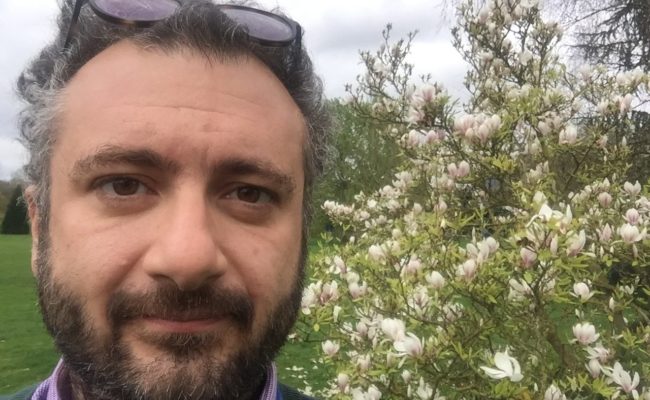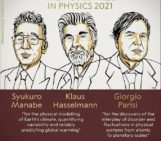
Today’s NP Interviews hosts the 2020 Lewis Fry Richardson Medal Valerio Lucarini.
Valerio (b. Ancona, Italy, 1976) is the Director of the Centre for the Mathematics of Planet Earth and Professor of Statistical Mechanics at the University of Reading, and former Professor of Theoretical Meteorology at the University of Hamburg. His main expertise is in Climate Dynamics, Extreme Events, Statistical Mechanics on Nonequilibrium Systems, Dynamical Systems, Stochastic Processes, Nonlinear Optics. He is author of more than 120 publications including two monographs and has contributed to the organization of over international 50 scientific events, including scientific schools in Les Houches, scientific programmes at the I. Newton Institute and at the H. Poincaré Institute, and two CliMathNet Conferences, and many EGU events. He has received several awards including the 2010 A. Richter Award of the European Geosciences Union, of the 2018 Whitehead Prize of the London Mathematical Society, and of the 2020 L.-F. Richardson Medal of the European Geosciences Union. In 2010 he was awarded an ERC Starting Investigator Grant. He is a fellow of the Royal Meteorological Society and of the Institute of Mathematics and its Applications.
The first question is obvious: what were your feelings when you received the news that you received the Richardson medal?
I was very very surprised and extremely happy. I received the news during the Trimester I was co-organising at the I. Poincare’ in Paris on “Mathematics of Climate and of the Environment”. So I was surrounded by many friend and colleagues. It has been a truly amazing feeling.
You received it for “his outstanding contributions to the fields of extreme value theory and climate science in general, with particular applications to climate modelling and prediction”, but what is the extreme value theory?
Extreme Value Theory (EVT) is a branch of probability theory that focuses on the study of unusually large (or small) and rare events and provides universal (or at least very general) results for the statistical properties of such events. For reasons that I have never really understood, it is somewhat overlooked in most climate applications (while being extremely popular in hydrology), despite its obvious relevance for a wealth of applications. As an example, it is only briefly mentioned in the IPCC reports. Together with a team of colleagues, in the mid 2010s we have been able to develop a theory of extreme events for chaotic and stochastic dynamical systems, having in mind applications in geosciences. The goal we have achieved has been to link in a robust and clear way the dynamics of such systems and the statistics of extreme events, in the form of a general link between the Lyapunov exponents and the so-called shape parameter of the EVT distribution of any observable. These general results have been then further developed and then used by some colleagues and friends to have a fresh look at the predictability of the atmosphere, by studying its recurrence properties. Somehow, EVT has help shedding light upon one of the classical problem in dynamical meteorology – the definition of weather analogues.
What were the main ideas that motivated your research? How has your work changed the understanding of the Earth system?
My approach to the study of the theoretical and mathematical aspects of the dynamics of climate has been very meandering, and I believe this has been a huge plus in my research. I started my career as a condensed matter physicist, then I moved to geosciences, then I got confused, and then I got confused again, oscillating between theory, applications, and wider interests in sustainability. I was politically very active at the time and I first considered delving into climate science after learning of Kyoto Protocol. I remember very well the huge impact of the 2001 IPCC report for an entire generation of students and scientists. Nonetheless, I had lots of difficulties during my graduate studies in geosciences, as I had hard time finding support for my … doubts and questions. I was also extremely unable to ask things in an intelligible way. At that time I decided that, if I had ever had the chance of supervising doctoral students, I would have do my best to guarantee them the most extreme freedom and give them my unconditional support. Of course I often fail on this, but this is what I honestly try to offer to my students.
On the one side I was enormously attracted by the beautifully complex phenomenology offered by geosciences. I find such a complexity extremely inspiring and, at the same time, very humbling (my first scientific hero is Charles Darwin).. On the other side, I was unsatisfied by what I perceived as the lack of a sufficiently coherent theoretical framework (my second scientific hero is Lev D. Landau). It has taken me a lot of time to be able to formulate my own scientific. I first approached the problem of better understanding the dynamics of climate by taking the point of view of macroscopic thermodynamics. The first results were promising – especially regarding the understanding of how the climate engine works and of special features of atmospheric circulation in exoplanets – and I have learnt a lot from these investigation, but then I had the feeling I was hitting a wall.
A key step forward has come from the intuition that response theory for nonequilibrium statistical mechanical system could be used for practically but rigorously predicting climate change using climate models. My background in condensed matter and especially the work I did as a student in Pisa (Italy) and then in Joensuu (Finland) played as essential role in seizing this opportunity.
With time, the study of the climate response has branched into achieving a better understanding of the relationship between climate change and variability – going beyond the usual fluctuation-dissipation theorem and variants thereof – and of tipping points. Nowadays I am focusing on tipping points and multistability in climate, also because I am part of the Horizon 2020 TiPES project, which includes some of my favourite colleagues in the field. I believe we are making rapid and promising progress in the basic understanding of tipping points.
A second – related – line of research that has been extremely fruitful and inspiring focuses on the study of the properties of high dimensional chaotic dynamical systems, and, especially, of their instabilities. We have used it to better understand the dynamics of geophysical flows, and to provide a new viewpoint of barotropic and baroclinic instabilities, and on the Lorenz energy cycle (the thermodynamics is indeed relevant!). I am especially satisfied with what we have learnt about the properties of blocking events, by proving that they are indeed associated to special modes of the atmosphere, specifically, special class of unstable periodic orbits. This paves the way, I believe, for an improved understanding of atmospheric predictability. I am also happy of what we have learnt about the development of parametrizations for multiscale systems.
Then, there is of course the investigation of extreme events, but we have already discussed this before.
The long paper I have recently written with Michael Ghil (The Physics of Climate variability and Climate Change, Rev. Modern Physics, in press) provides a very comprehensive account of what is important to me now in the broad area of climate science. I hope it will be useful for many colleagues and many students.
Finally, I believe that the impact of my work for the understanding of Earth system is also if not especially indirect, in the sense that I see that many of my former students and collaborators are making fantastic progress in directions I would have never been able to explore. This is, of course, a great feeling.
What were the key people that contributed to increase your motivation on this field?
Many friends and colleagues have given me inspiration, mentoring, guidance, and intellectual challenges. These exchanges have been essential to learn how to improve my work and how to develop my own research style and how to define my scientific priorities. I am particularly grateful to Henk Dijkstra, Bruno Eckhardt (who sadly passed away last summer), Klaus Fraedrich, Giovanni Gallavotti, Michael Ghil, Darryl Holm, Brian Hoskins, Joel Lebowitz, David Ruelle, Antonio Speranza, Tamás Tél, and Jim Yorke. Their influence on my work, in terms of methods and scope of my research, is enormous. Apart from these Grandmasters, other beautiful minds push me forward and humble me every single day – Tamás Bódai, Niklas Boers, Mickäel Chekroun, Ira Didenkulova, Bérengère Dubrulle, Davide Faranda, Gary Froyland, Georg Gottwald, Andrey Gritsun, Tobias Kuna, Beatrice Pelloni, Francesco Ragone, Alexis Tantet, Jeroen Wouters, among others. And, of course, the interaction with students is essential for sharpening one’s science. I have been blessed by having the honour of mentoring and supervising some really amazing individuals, who have been able and are able to ramp up my motivations and open my mind. I am so grateful to all of them.
I also wish to mention – especially for the benefit of early career scientists – that not all scientific interactions have been positive or fair. Many scientists, powerful and not, have tried very hard to discourage and belittle me, and sometimes I felt I was being bullied. This has happened throughout my career, in direct or indirect ways. Obviously, I am not talking of harsh scientific criticism to my work, which is always welcome and appreciated, no matter what. Unfortunately abuse is a common experience for many of us, and I am sure that if I had not had strong support around me (and a sometimes unhealthy degree of stubbornness and self-confidence), these negative pressures would have prevented me from growing as a scientist. Some scientists can be extremely and idiotically cruel, and the scientific community is sometimes unable to deal with this sort (and many other ones, in fact) of misconducts, especially if the perpetrators are sufficiently senior and scientifically influential. I find this abhorrent and I have zero tolerance for this attitude, which impacts disproportionally some categories of people, hampering inclusiveness.
Finally, the usual question: what do you wish for the future and how young/established researchers can contribute to the growth of the nonlinear geophysics/geosciences?
First and foremost, I wish for more inclusiveness and diversity in our scientific area and in science at large and, as hinted above, a more welcoming and fair working environment. We still have a huge gender gap (see also my list above), and the limited opportunities of career advancement in science are enforcing an increasingly serious class gap. And, obviously, we need strong support for science in the Global South, where, at the same time, some of the greatest scientific/societal challenges and some of the best talents are located. I believe that we should try to set up a global academy in geosciences in the style and spirit of CIMPA (for Mathematics) and various institutes set up by ICTP (for Physics), and, indeed, join forces with them.
I believe that, in order to address the climate crisis, we need to be imaginative and brave, and walk untrodden paths. As far as our specific research area of nonlinear geophysics is concerned, I believe that we are in a phase of fantastic opportunities. Geosciences, mathematics, physics, biology, data science are more and more entwined and wonderful scientific challenges are ahead of us, in terms of specific research questions and of new formal and numerical methodologies to be developed for data analysis and processing. We are probably at the dawn of a new kind of science, to paraphrase Steve Wolfram. New generations of imaginative and interdisciplinary scientists will develop it.


